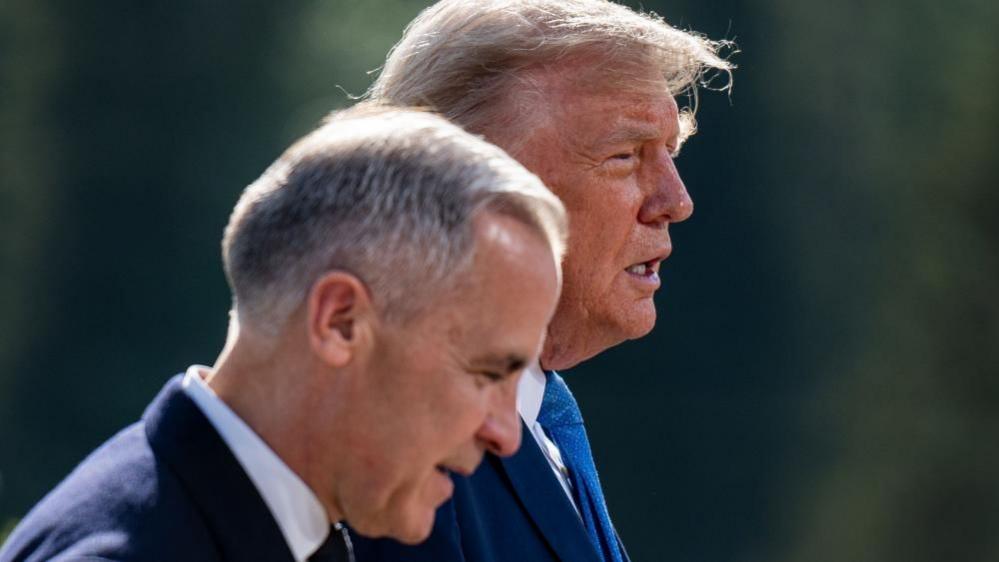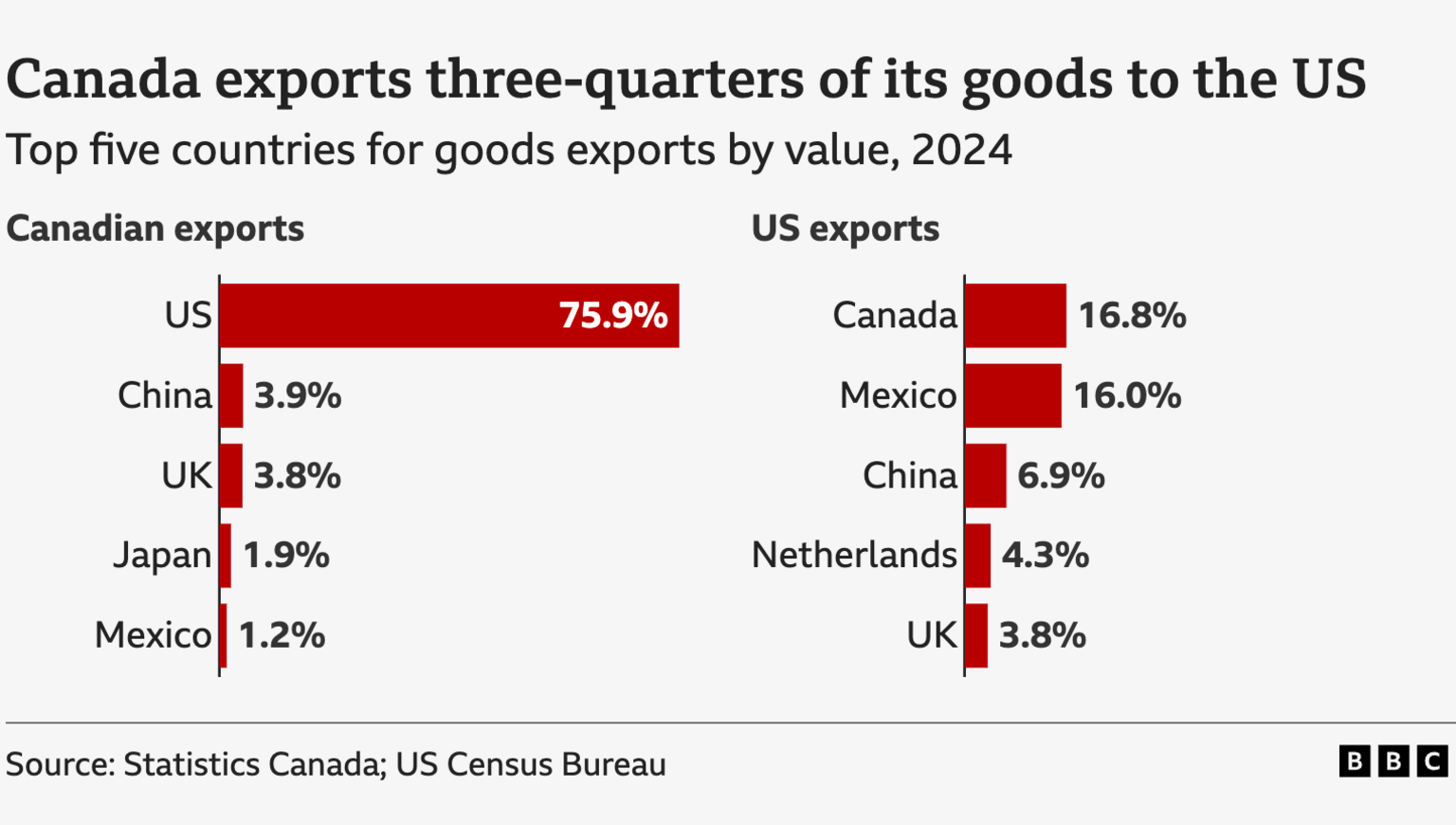After a blown deadline, what next for US-Canada trade?

- Published
A self-imposed deadline for a new US-Canada trade deal came and went on Friday. So what happens next for these two deeply entwined neighbours?
Canada and the US have been locked in a tariff war for six months and, despite talk of "intense" negotiations in recent weeks, a trade agreement remains elusive.
Both President Donald Trump and Prime Minister Mark Carney have poured cold water on the idea they will reach a quick, and tariff-free, deal. And Trump's open criticism of Canada's move to recognise a Palestinian state dashed hopes for a last-minute agreement earlier this week.
The pessimism marks a shift in tone from as recently as June's G7 meeting, when the two leaders set themselves the summer deadline.
Canadian negotiators have come to the conclusion that "it's not the end of the world" if a quick deal isn't reached and "that quality over speed and a rushed agreement matters a lot", said Fen Hampson, a professor of international affairs at Carleton University in Ottawa.
Carney - who has been tight-lipped about the negotiation details - has said as much himself, repeating that just "any deal" won't do.
Still, there are pressures on both sides to give businesses a reprieve.
Conservative leader Pierre Poilievre said on Friday he shares "Canadians' disappointment" that a deal was not reached by the deadline. He urged Carney's Liberals to do more to "take back control of our economic future".
Canada is now facing a 35% tariff rate, though there is a carve out for goods compliant under a current free trade deal. American global tariffs on steel, aluminium, autos and auto parts are hurting, as the US is a top market for those sectors.
On Sunday, Canada's minister for US-Canada trade Dominic LeBlanc told the BBC's US partner CBS News that trade talks will continue, and that negotiations so far have been "informative, constructive and cordial."
LeBlanc added he expects Carney and Trump to speak again in the coming days.
"We think there is an option of striking a deal that will bring down some of these tariffs, and provide greater certainty to investment," he said.
The Trump administration has justified those tariffs by claiming a lack of co-operation on stemming the flow of illicit drugs like fentanyl. Canada denies that, noting about 1% of US fentanyl imports originate in Canada. It has also brought in new border protections and a "fentanyl czar" in recent months in an effort to address Trump's concerns.
Threatened tariffs on copper and the expected end of a global tariff exemption used by shoppers of goods under $800 could also pinch.
Canada has responded with C$60bn, external ($43.3bn; £32.3bn) in counter tariffs on various American goods - the only country along with China, external to directly retaliate against Trump.
"It comes as no surprise that businesses are craving certainty after months and months of tumultuous announcements," said Catherine Fortin-Lefaivre, vice-president of international policy and global partnership at the Canadian Chamber of Commerce.
"But at the same time, they're not craving certainty at the expense of a really bad deal."

A few factors give Canada some breathing room.
On paper, it looks like the country is facing a severe tariff rate from the US, but trade is currently more free than the levies suggest at first glance.
In March, Trump announced a tariffs reprieve on goods compliant with the Canada–United States–Mexico Agreement, known in Canada as CUSMA and the US as the USMCA.
That deal - negotiated during Trump's first term in office - came into force five years ago.
Almost 90% of Canadian exports to the US are ultimately able to cross the border duty free, if firms file out necessary paperwork, under that agreement.
"That has given us a buffer, no question about it, that other countries don't have right now," said Prof Hampson.
It means Canada is overall paying a much lower tariff rate than many of the deals already inked with the US, like the EU, South Korea and Japan at 15%, or Indonesia and the Philippines at 19%.
Ottawa has also brought in some relief programmes for affected industries and has also collected about C$1.5bn more in import duties than in the same period last year, due to the counter tariffs.
And while in the US consumer confidence is up and prices there have remained contained, it helps Canada's negotiating position if they can wait for Americans to start feeling the pain of tariffs.
"It's Americans who are going to squawk," said Prof Hampson.
Ms Fortin-Lefaivre predicts US businesses, especially smaller firms that don't have the same resources to withstand them, will be pressuring political leaders.
"So that pressure could play to our advantage," she said.
Canadians also appear willing to give the new prime minister some leeway. Opinion polls suggest they are generally satisfied with his handling of trade.
Carney "understands that doing what's best for the economy right now is actually what's best for him politically", Martha Hall Findlay, director of the University of Calgary's School of Public Policy and a former Liberal MP, told the BBC.
Trump has said he is imposing tariffs to boost domestic manufacturing, open overseas markets and raise money for the government.
He is also using them to push countries like Canada on a range of non-trade issues, including military spending.
In the last few weeks, Ottawa has significantly ramped up its defence spending, boosted security at the shared border and killed a digital tax opposed by American tech firms.
Those moves show Canada is "doing what the Americans wanted us to do", said Ms Fortin-Lefaivre.
She hopes Canadian negotiators are pushing for tariffs to be as low as possible, as well as working to ensure the two deeply integrated supply chains are able to continue working together.
Canada is pressing for relief on the 50% steel and aluminium tariffs, which are squeezing US automakers.
And on Thursday, Treasury Secretary Scott Bessent signalled in an interview with CNBC that is an option on the table.
Watch: Why Mexico got a tariff reprieve... and Canada didn't
Trump meanwhile, has raised a number of longstanding trade irritants besides fentanyl, including Canada's protections around its dairy industry.
Ottawa has previously warned of more countermeasures to come if talks collapse, though political appetite for that may be waning.
Retaliatory tariffs "haven't seemed to have had the kind of impact that we would hope for", British Columbia Premier David Eby recently told Bloomberg.
On retaliation, Prof Hampson said: "The Americans have escalation dominance here. So you want to be smart about it."
A spokesperson for Carney declined to say whether more countermeasures remained on the table. Meanwhile, Canadian negotiators have been in Washington most of this week and keep pushing talks forward, with the minister responsible for Canada-US trade saying on Friday , externalan acceptable agreement "was not yet in sight".
"We all crave the certainty of a deal," said Ms Fortin-Lefaivre.
But research by her business group suggests firms are making contingency plans. Almost 40% of goods exporters have already diversified suppliers outside the US, and 28% have diversified buyers.
They are also looking ahead to what may be more challenging talks with CUSMA, which has proven a critical backstop, as it is up for review next year.
It is all part of a wider push by the country to diversify trade away from the US, pull down barriers that have hindered trade between provinces, and press forward more quickly on major projects.
The economic links between the two countries will stay strong - Canada will still be one of the largest trading partners and economic and security allies of the US.
But the irony is that Trump's threats may be "forcing Canada to understand we have to get our own economic house in order," said Ms Hall Findlay.
"It's going to take some really tough decisions. And I do think our current government gets this."